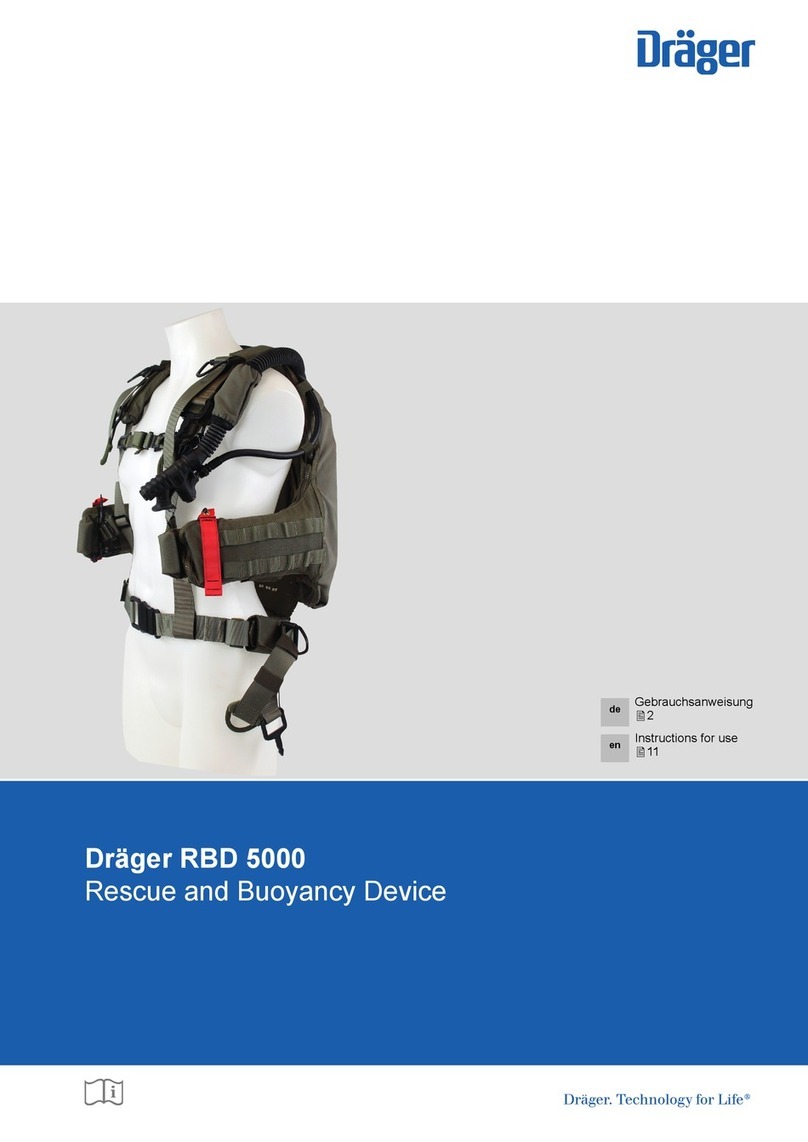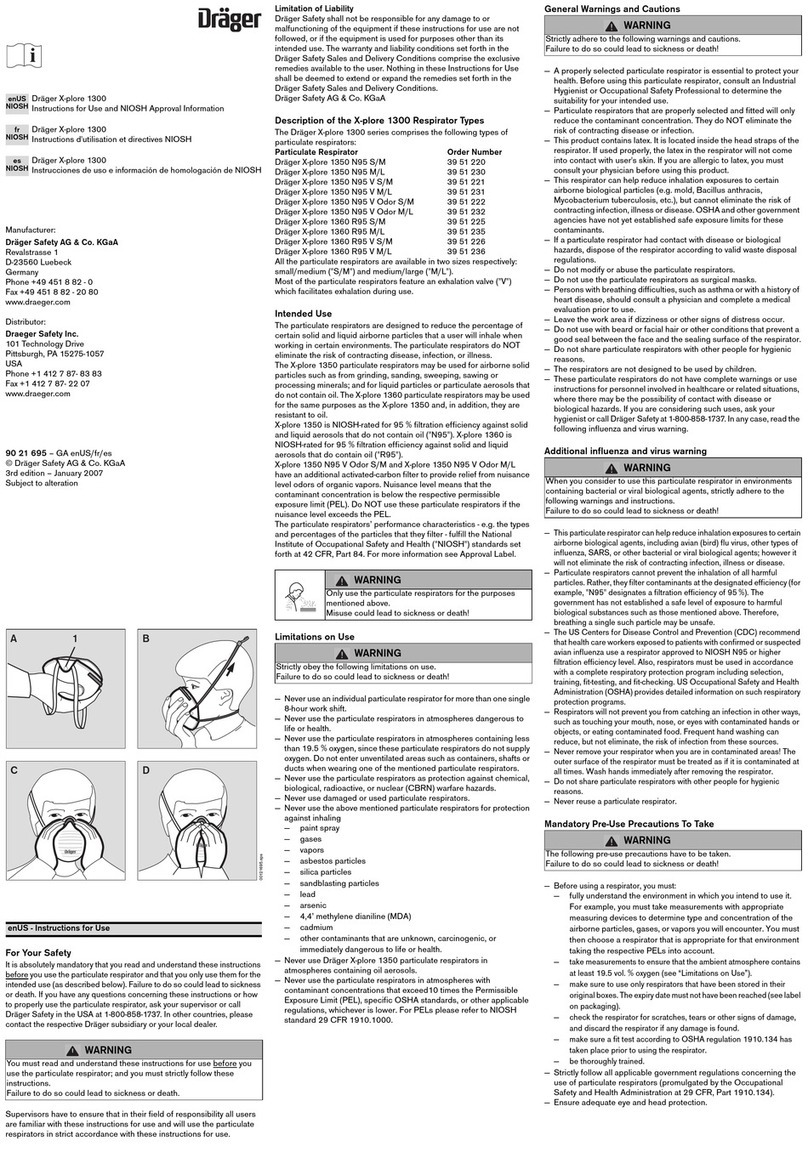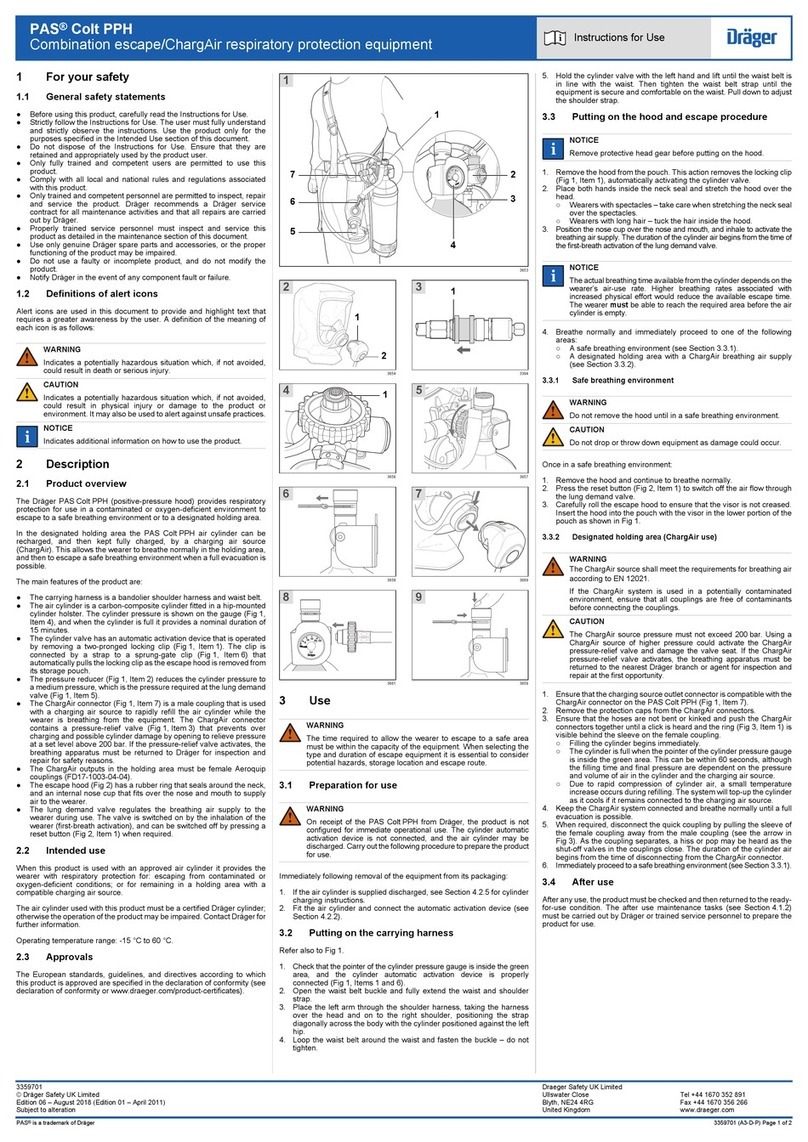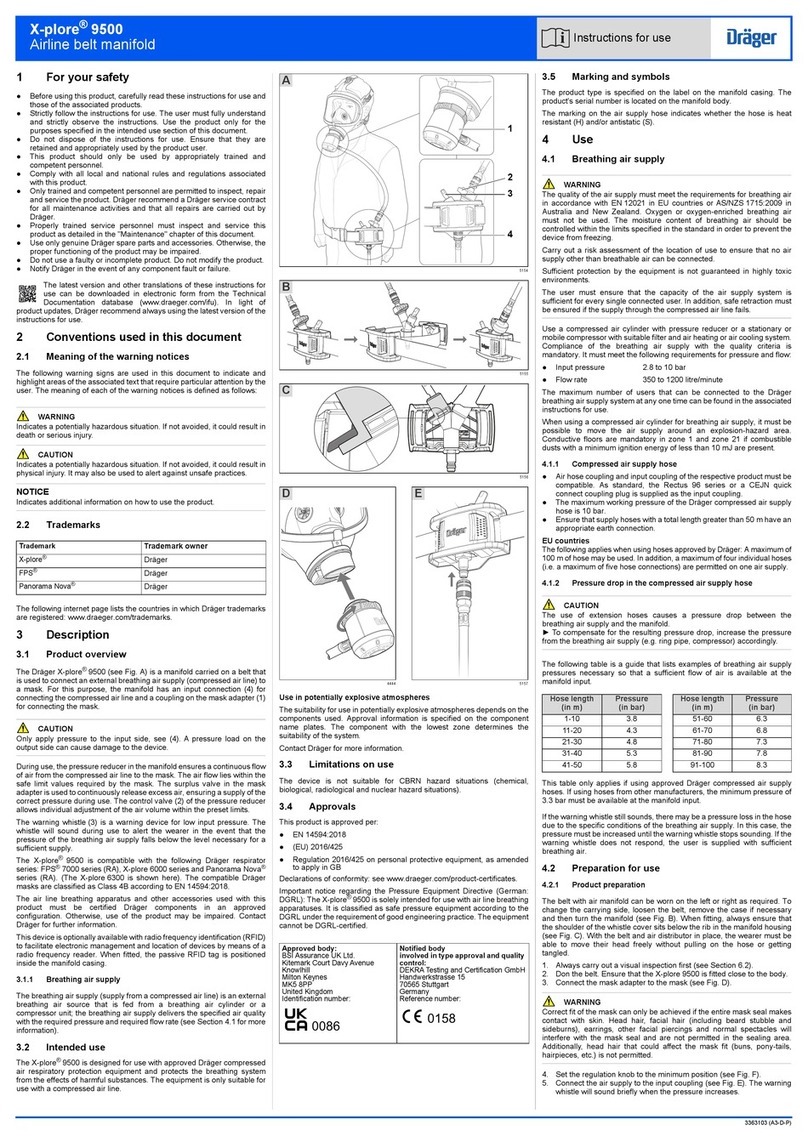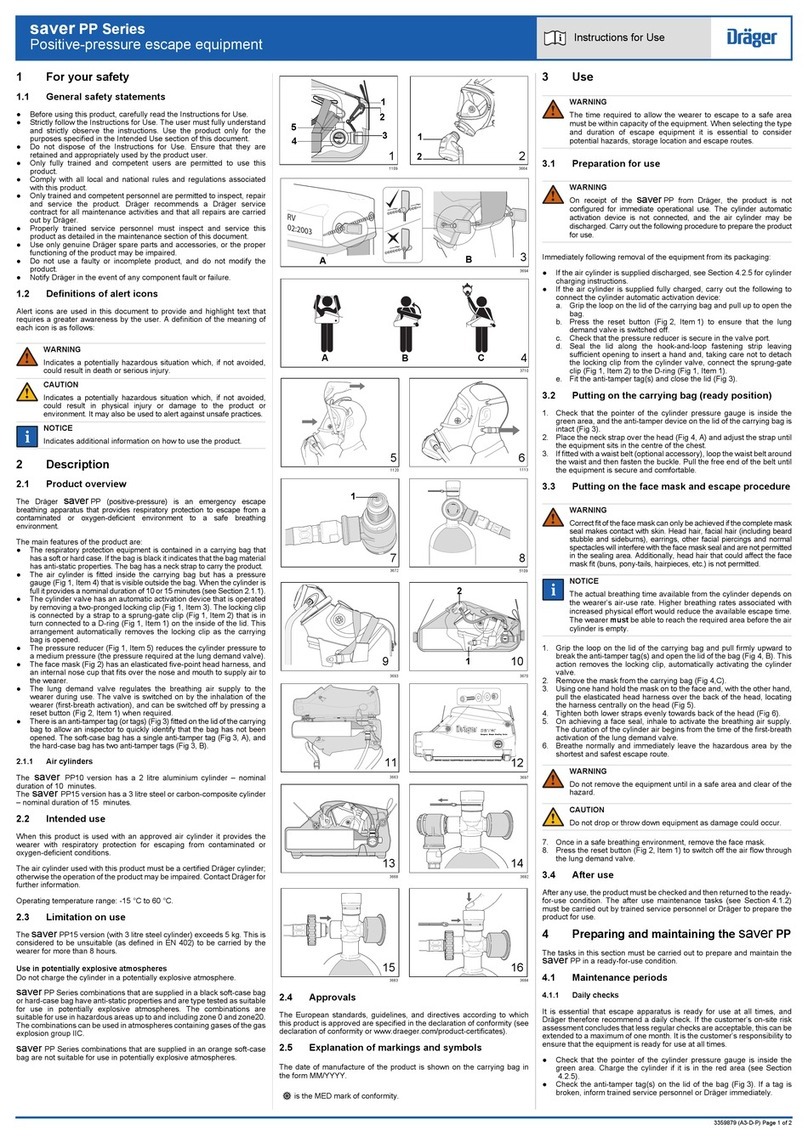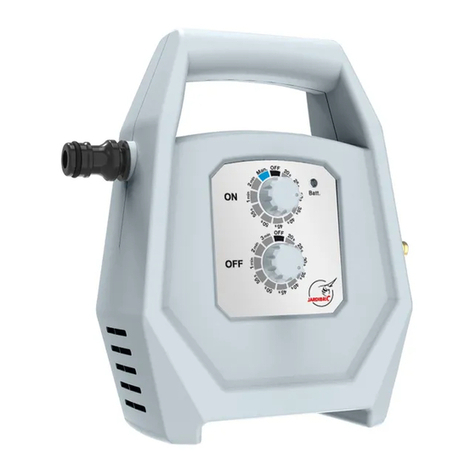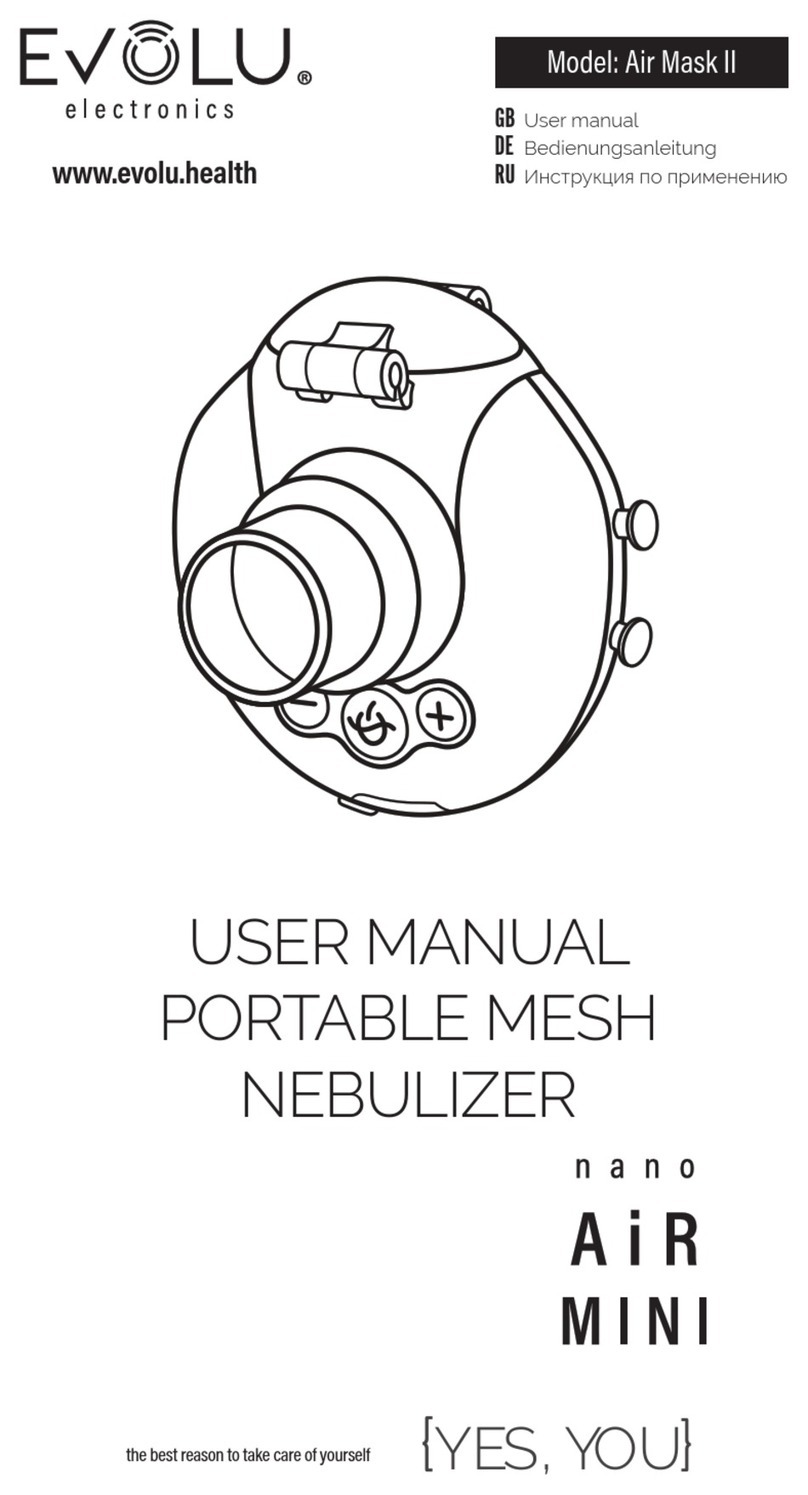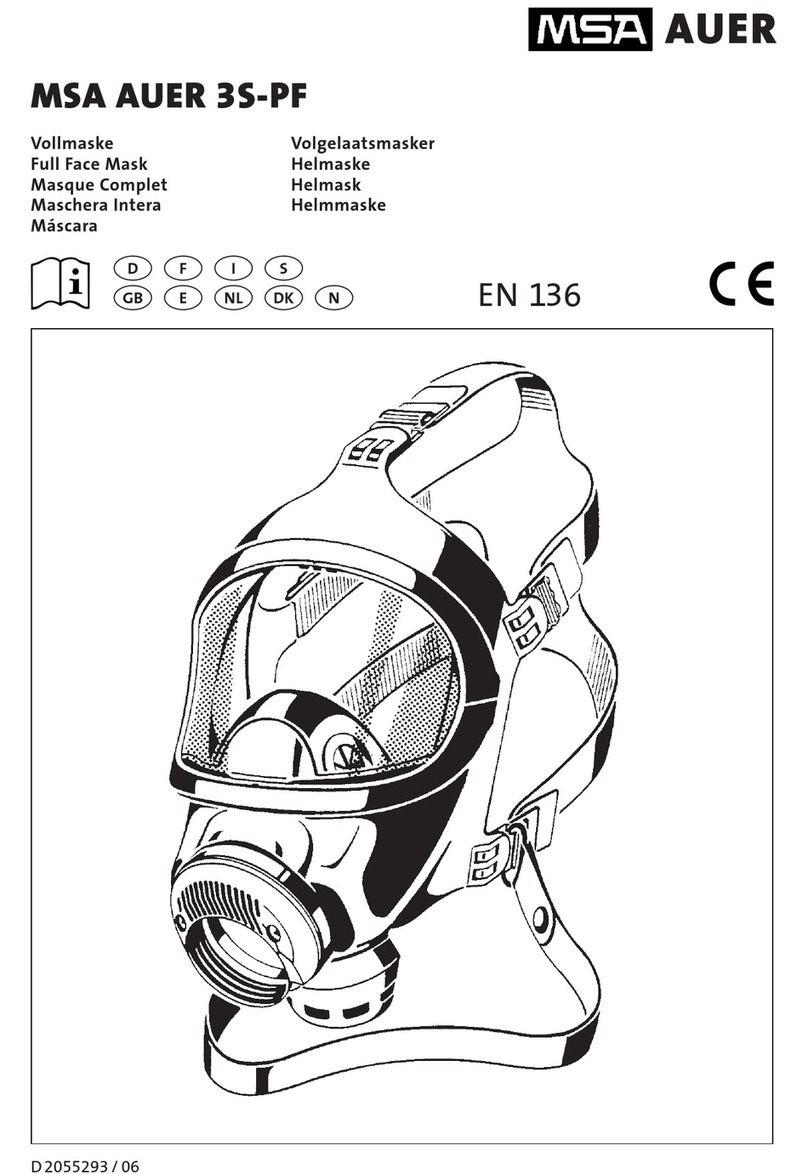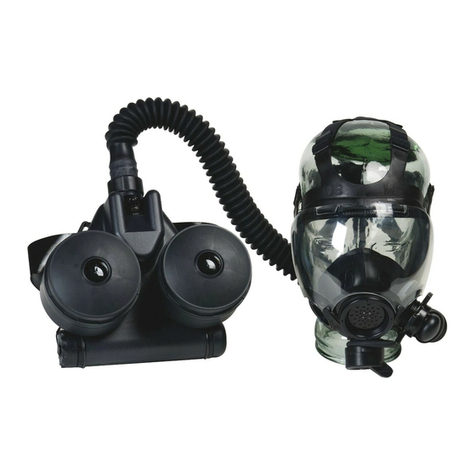
PAS®is a registered trademark of Dräger 3352422 (A3-D-P) 1 / 2
3352422
© Dräger Safety UK Limited
Edition 07 – October 2018
Subject to alteration
Draeger Safety UK Limited
Ullswater Close Tel +44 1670 352 891
Blyth, NE24 4RG Fax +44 1670 356 266
United Kingdom www.draeger.com
PAS®Colt Series
Escape respiratory protection equipment Instructions for use
1 For your safety
1.1 General safety statements
●Before using this product, carefully read the Instructions for Use.
●Strictly follow the Instructions for Use. The user must fully understand
and strictly observe the instructions. Use the product only for the
purposes specified in the Intended Use section of this document.
●Do not dispose of the Instructions for Use. Ensure that they are
retained and appropriately used by the product user.
●Only fully trained and competent users are permitted to use this product.
●Comply with all local and national rules and regulations associated
with this product.
●Only trained and competent personnel are permitted to inspect, repair and
service the product. Dräger recommend a Dräger service contract for all
maintenance activities and that all repairs are carried out by Dräger.
●Properly trained service personnel must inspect and service this
product as detailed in the Maintenance section of this document.
●Use only genuine Dräger spare parts and accessories, or the proper
functioning of the product may be impaired.
●Do not use a faulty or incomplete product, and do not modify the
product.
●Notify Dräger in the event of any component fault or failure.
●The air supply shall meet the requirements for breathing air according
to EN 12021.
1.2 Definitions of alert icons
Alert icons are used in this document to provide and highlight text that
requires a greater awareness by the user. A definition of the meaning of
each icon is as follows:
WARNING
Indicates a potentially hazardous situation which, if not avoided,
could result in death or serious injury.
CAUTION
Indicates a potentially hazardous situation which, if not avoided,
could result in physical injury or damage to the product or
environment. It may also be used to alert against unsafe practices.
NOTICE
Indicates additional information on how to use the product.
2 Description
2.1 Product overview
This variant of the Dräger PAS Colt Series provides respiratory protection
for escaping from a contaminated environment using breathing air from the
air cylinder.
The equipment is available as a 10 minute, 15 minute or 20 minute
version. These are the nominal escape durations, which are determined by
the capacity (volume and pressure rating) of the air cylinder selected. The
actual escape duration is also dependent on the rate at which the wearer
uses air from the cylinder (the breathing rate).
The features of the equipment are:
●The carrying system is a bandolier shoulder harness and waist belt
with a hip mounted cylinder holster.
●The pressure reducer (Fig 1, Item 2) connects directly on to the air
cylinder, and reduces the cylinder pressure to the medium pressure
required at the lung demand valve (Fig 1, Item 1).
●The Dräger air cylinder and lung demand valve are described below.
Optional features:
●Dropdown cylinder holster: assists wearer movement by making the
cylinder and holster more manoeuvrable (in a confined space for
example).
●ChargAir direct filling system: see the ChargAir Instructions for Use for
a description and operating instructions.
2.1.1 Air cylinder
Cylinders are available with a 200 bar or 300 bar working pressure rating,
and in steel, aluminium or composite materials. The pressure in the air
cylinder is shown on a contents indicator on the cylinder. Only air cylinders
listed in the Dräger certification are approved for use with the PAS Colt.
Contact Dräger for further information.
2.1.2 Lung demand valve (LDV)
A variety of Dräger lung demand valves are compatible with this
equipment, with the coupling (Fig 2, Item 1) selected to match the face
mask coupling (see table below):
During use, the lung demand valve activates automatically as the wearer
breathes, and then regulates the breathing air supply into the face mask in
response to the breathing rate of the wearer.
●On positive-pressure systems, when the lung demand valve is
activated, the internal valve remains open until closed by the user.
Positive-pressure valves have a reset button (Fig 2, Item 2) that closes
the valve when required. Pressing the reset button closes the internal
valve to switch off the air flow through the lung demand valve.
●On negative-pressure systems the internal valve closes automatically
to switch off the air flow through the lung demand valve.
2.2 Intended use
When this product is used with an approved face mask, air cylinder and
lung demand valve, it provides the wearer with respiratory protection for
escaping from contaminated or oxygen-deficient conditions. It is intended
for use in applications where a high level of respiratory protection is
required. The equipment is intended to be used only for escape
applications.
LDV
coupling
Face
mask
coupling
Type Coupling type
A P Positive
pressure
Push-in – Dräger specific
AE PE Positive
pressure
Screw-in – M45 x 3 to EN 148-3
N RA Negative
pressure
Screw-in – 40 mm round thread
to EN 148-1
!
The air cylinder, face mask (full face mask conforming to EN 136 Class 2
or Class 3) and other accessories used with this product must be certified
Dräger components, assembled in an approved configuration; otherwise
the operation of the device may be impaired. Contact Dräger for further
information.
2.3 Limitations on use
This product is not approved for use in CBRN applications.
Use in potentially explosive atmospheres
●The PAS Colt Series are type tested as suitable for use in potentially
explosive atmospheres. Electronic sub-assemblies are ATEX certified.
The combinations are suitable for use in hazardous areas up to and
including zone 0 and zone 20. The combinations can be used in
atmospheres containing gases of the gas explosion group IIC, with the
exception of combinations using the f 2 range of face masks, which are
only suitable to be used in atmospheres containing gases of the gas
explosion group IIB.
●Do not charge the cylinder in a potentially explosive atmosphere.
2.4 Approvals
The European standards, guidelines, and directives according to which
this product is approved are specified in the declaration of conformity (see
declaration of conformity or www.draeger.com/product-certificates).
3 Use
WARNING
The time required to allow the wearer to escape to a safe area
must be within the capacity of the cylinder selected, taking into
account the breathing rate of the wearer. When selecting the type
and duration of escape equipment it is essential to consider
escape routes and potential hazards.
The cylinder air quality shall meet the requirements for breathing
air according to EN 12021.
3.1 Preparation for use
3.1.1 Visual inspection
Carry out a visual inspection, checking the full breathing apparatus
including all component parts and accessories. Check that the equipment
Dräger
Dräger
3720 3625
3626 3714
3715 3748
is clean and undamaged, paying particular attention to pneumatic
components, hoses and connectors. Typical signs of damage that may
affect the operation of the breathing apparatus include impact, abrasion,
cutting, corrosion and discoloration. Report damage to service personnel
and do not use the apparatus until faults are rectified.
3.1.2 Fitting the cylinder
CAUTION
If the PAS Colt is a 300 bar unit fitted with ChargAir, the pressure
reducer will not accept a 200 bar cylinder. Do not attempt to
connect a cylinder with the incorrect pressure rating.
1. Ensure that the cylinder is fully charged, with the pointer of the cylinder
pressure indicator inside the green area.
2. Check the threads of the cylinder valve port and the pressure reducer.
Ensure that the O-ring seal (Fig 3, Item 1) and the sintered filter (Fig 3,
Item 2) in the reducer are clean and undamaged.
3. Fully insert the cylinder into the carrying holster. To prevent damage,
ensure that the cylinder remains clear of the hand wheel of the
pressure reducer while inserting the cylinder.
4. Align the cylinder with the pressure reducer and tighten the hand wheel
hand tight (Fig 4). Do not use tools or over tighten.
3.1.3 Functional testing
Leak test
WARNING
If the breathing apparatus fails to meet any of the standards or
parameters described in the functional tests, or if an immediate
leak is evident, there is a system fault. Report the fault to trained
service personnel or contact Dräger. Do not use the breathing
apparatus until the fault condition is rectified.
1. Ensure that the pointer of the cylinder pressure indicator is inside the
green area.
2. Positive-pressure systems: press the reset button (Fig 2, Item 2) to
switch off the valve.
3. Open the cylinder valve slowly, but fully, to pressurize the system, and
then close the cylinder valve.
4. Check for audible leaks. If there is any leak, investigate and repair the
leak before use (see Section 4). If necessary, use a soapy solution to
locate the leak.
5. Press the front button (Fig 5) (fold back the rubber cover to press the
button and then immediately refit the rubber cover) to fully vent the
system.
6. Positive-pressure systems: press the reset button (Fig 2, Item 2) to
switch off the valve.
3.1.4 Putting on the PAS Colt (ready position)
See also Fig 1 which shows the PAS Colt worn in the ready position.
1. Ensure the pointer of the cylinder pressure indicator is inside the
green area.
2. Open the waist belt buckle and fully extend the waist belt and shoulder
strap.
3. Place the left arm through the shoulder harness, taking the harness over
the head and on to the right shoulder, positioning the strap diagonally
across the body with the cylinder positioned against the left hip.
4. Loop the waist belt around the waist and fasten the buckle – do not
tighten.
5. Grip the cylinder valve with the left hand and lift until the waist belt is in
line with the waist. Then tighten the waist belt strap until the equipment
is secure and comfortable on the waist. Pull down to adjust the
shoulder strap.
6. Check that the face mask port, and the lung demand valve coupling
and O-ring are clean and undamaged.
7. Connect the lung demand valve to the face mask as follows:
○Push-in coupling: press into the port of the face mask until it
latches in position. Check the attachment by gently attempting to
pull the coupling apart.
○Screw-in coupling: screw into the port of the face mask and
tighten hand tight. When the lung demand valve is fitted to the
face mask, the connector can swivel to allow for head and body
movement of the wearer.
8. Put the neck strap of the face mask over the head, and then insert the
neck strap stud into the hole in the centre strap of the head harness.
3.2 During use
3.2.1 Putting on the face mask
WARNING
Correct fit of the face mask can only be achieved if the complete
mask seal makes contact with skin. Head hair, facial hair (including
beard stubble and sideburns), earrings, other facial piercings and
normal spectacles will interfere with the mask seal and are not
permitted in the sealing area. Additionally, head hair that could affect
the face mask fit (buns, pony-tails, hairpieces, etc.) is not permitted.
The duration available for escape starts from the time that the wearer
commences breathing from the air cylinder, and is dependent on the
capacity of the cylinder and the breathing rate of the wearer.
NOTICE
Refer also to the face mask Instructions for Use.
1. Positive-pressure systems: press the reset button (Fig 2, Item 2) to
switch off the valve.
2. Open the cylinder valve slowly, but fully, to pressurize the system.
3. Detach the neck strap stud from the centre strap of the head harness.
4. Spread the head harness (Fig 6). Place the chin into the chin cup of
the face mask and pull the harness over the head locating the harness
centre plate on back of the head.
5. Referring to Fig 7, tighten both lower (1) and then upper straps (2)
evenly towards the back of the head. If necessary, tighten the centre
strap (3).
6. Breathe normally and immediately leave the hazardous area by the
shortest and safest escape route.
The wearer must be in a safe area before the air cylinder is empty. When
in a safe area, remove the lung demand valve from the face mask if
necessary and continue to breathe normally.
!
!




